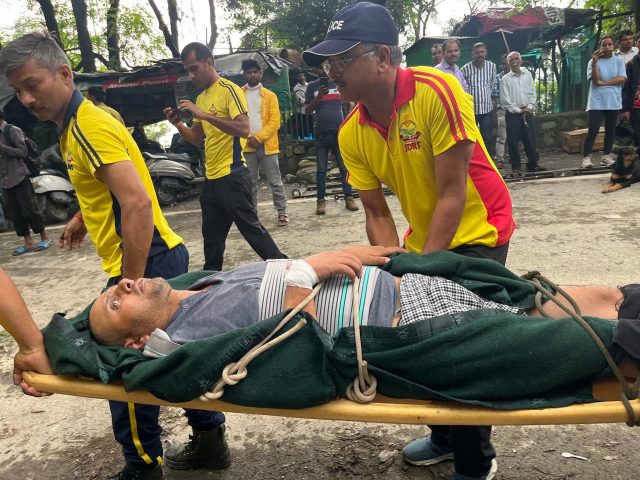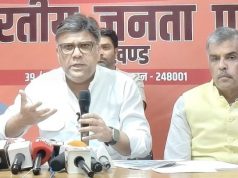By ARUN PRATAP SINGH
Garhwal Post Bureau
Dehradun, 17 Sept: The cloudburst and torrential rains that struck Dehradun two days ago have left the capital city of Uttarakhand reeling. Entire neighbourhoods remain waterlogged or cut off, bridges have collapsed, power supply stands crippled across hundreds of villages, and arterial roads to Mussoorie and Paonta Sahib continue to be blocked. Relief operations by SDRF and NDRF are in full swing, yet the sense of despair in the valley is palpable. But to treat this tragedy merely as another act of nature would be to miss the bigger truth: this disaster was as much man-made as it was meteorological.

For decades, institutions mandated to protect and regulate the city’s growth, the district administration, the Mussoorie–Dehradun Development Authority (MDDA), the Doon Nagar Nigam, and the forest department, as well as the government have failed badly in their duties to regulate. Local and state level politicians are also to be blamed for promoting illegal mining and encroachments as well as for open violation of urban building bylaws and norms. Their compliance to encroachments on riverbanks, illegal mining of sand and boulders, and wholesome violation of the city’s master plan has systematically eroded natural safeguards.

Dehradun’s present plight begins to look less like a natural calamity and more like the logical culmination of decades of misgovernance.
The banks of the Rispana and Bindal rivers today resemble dumping grounds, narrowed and choked by illegal colonies, commercial complexes, and debris. The natural drainage system that once absorbed excess rainfall has been throttled. In their greed for revenue and appeasement of vote banks, authorities sanctioned or ignored construction in prohibited floodplains, turning rivers into ticking time bombs. Simultaneously, indiscriminate mining in the Tons and Song rivers has destabilised riverbeds, accelerating erosion and making bridges and embankments vulnerable. Even the nullahs and drains and the canals that flowed along the roadsides across Dehradun have been closed, choked or neglected.
The present collapse of the Mussoorie road near the Shiv Temple or the bridge at Premnagar are not isolated freak accidents. They are the physical manifestations of decades of unregulated development, repeated warnings brushed aside, and a planning culture where violations were regularised instead of penalised. This cycle of complicity has transformed Dehradun from a natural basin protected by forests and rivers into a fragile, overcrowded sprawl highly vulnerable to floods and landslides.
It is however important to recognise, that development cannot be wished away. Dehradun’s population has grown exponentially since it became the state capital in 2000. Migrants, government offices, institutions, and industries have expanded the city beyond recognition. Infrastructure has not merely lagged; it has been overwhelmed. In view of these facts, arguments in favour of projects such as the proposed Rispana and Bindal elevated corridors, or the construction of ring roads to ease congestion, is unquestionable. But what has to be considered totally indefensible is the utter disregard for planning norms, environmental studies, and disaster-mitigation principles in implementing these projects.
The lesson of this tragedy is not that Dehradun needs to resist development, but that it needs to embrace planned, regulated, and ecologically sensitive development. Strict enforcement of the master plan, preservation of river corridors, scientific zoning, and transparent public accountability must form the backbone of urban governance. The administration must end the culture of “regularising” illegal colonies and instead commit to long-term resilience planning. The MDDA and Nagar Nigam cannot continue as rubber-stamp bodies; they must evolve into genuine planning authorities with both vision and teeth.
What makes the present disaster particularly sad is the fact that Dehradun has traditionally been the hub of relief and rescue operations for calamities in the hill districts. From Dharali to Tharali, it has historically functioned as the logistical lifeline for the mountains during monsoon disasters. This time, however, the city itself has become the epicentre of destruction, paralysed and dependent on outside assistance. If the capital of Uttarakhand, with its concentration of administrative machinery, could be brought to its knees so swiftly, the vulnerability of the state as a whole stands brutally exposed.
The tragedy in Dehradun should therefore serve as a watershed moment. If political leaders continue to see the city’s rivers and forests as real estate opportunities, if officials persist in ignoring encroachments, if citizens themselves acquiesce to illegal expansion in pursuit of convenience, then such disasters will recur with increasing ferocity. The devastation of the past two days is, therefore, not solely the work of nature. It is the product of decades of administrative apathy, unregulated construction, and political expediency. If the city is to recover and safeguard itself against the next deluge, urban governance must abandon the culture of compromise. Development is inevitable and indeed necessary, but it must be regulated, scientifically planned, and enforced without fear or favour. Otherwise, Dehradun will remain condemned to repeat this cycle of disaster and grief with every season of heavy rain.






